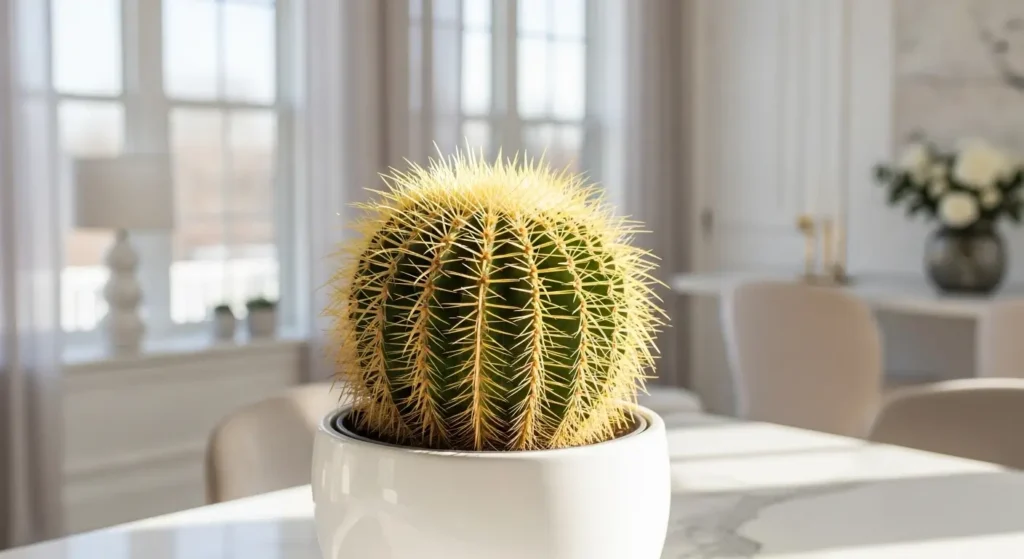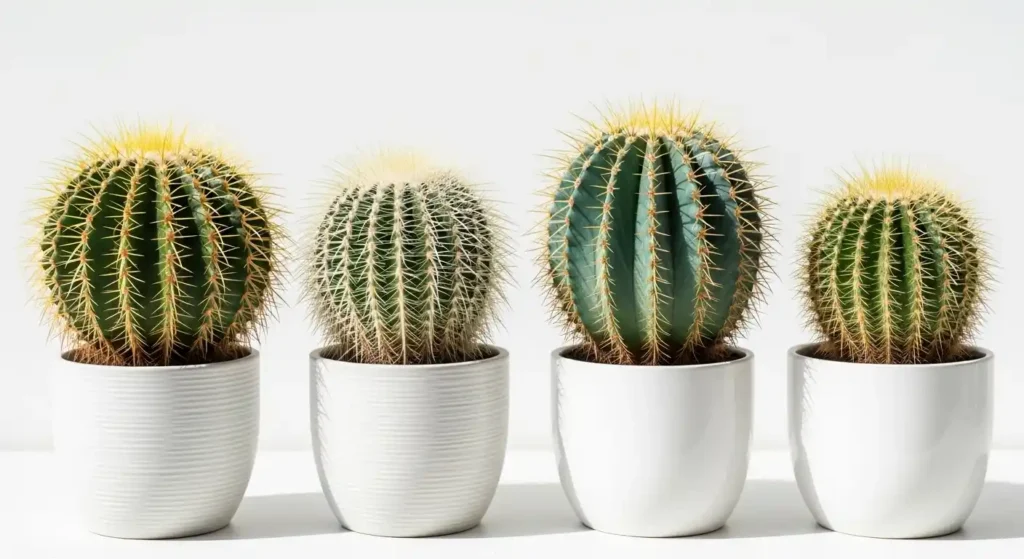
In This Article
The golden barrel cactus (Echinocactus grusonii) is one of the most iconic desert plants you can grow at home. Its perfectly round shape and stunning golden spines make it an absolute showstopper in any collection. Native to central Mexico, specifically the states of Querétaro and Hidalgo, this gorgeous cactus has earned fun nicknames like “mother-in-law’s cushion” and “golden ball.”
Here’s the thing: while it’s endangered in the wild due to habitat loss, golden barrel cactus thrives beautifully in home gardens and containers. With a potential lifespan of 30 years or more, this slow-growing beauty is a long-term companion. The care level? Pretty easy, honestly. If you can resist overwatering, you’re already halfway there.
| Plant Care Card | |
|---|---|
| Common Name | Golden Barrel Cactus |
| Botanical Name | Echinocactus grusonii |
| Family | Cactaceae |
| Plant Type | Perennial cactus |
| Mature Size | 3 ft. tall × 3 ft. wide |
| Sun Exposure | Full sun to bright light |
| Soil Type | Well-draining, sandy |
| Soil pH | 6.1–7.5 (slightly acidic to neutral) |
| Hardiness Zones | USDA 9a–11b |
| Native Area | Central Mexico |
| Toxicity | Non-toxic to pets (spines can cause injury) |
Golden Barrel Cactus Care
Caring for a golden barrel cactus is surprisingly simple once you understand its desert origins. The following sections cover everything from light to watering and beyond. You’ll love how low-maintenance this plant actually is!
Light
Golden barrel cactus craves bright light ideally six to eight hours of direct sunlight daily. A south-facing window works perfectly for indoor plants. Younger plants actually prefer bright indirect light with some protection from harsh afternoon rays.
If your cactus starts leaning dramatically toward the light source, that’s its way of begging for more sun. Outdoors, full sun is ideal in most climates, though in extremely hot desert areas, some afternoon shade prevents sunburn. Watch for pale or yellowing skin, which signals too much intense exposure.
Soil
The right soil mix makes all the difference between a thriving golden barrel cactus and a rotting one. You need fast-draining, gritty soil that doesn’t hold moisture. A commercial cactus mix amended with extra perlite or coarse sand works well.
For a DIY approach, try mixing 1 part potting soil, 1 part coarse sand, and 1 part perlite. According to the University of Minnesota Extension, cacti require well-drained sandy soil and containers with drainage holes to prevent root rot. Never use regular potting soil alone it retains too much moisture.
Water
Watering is where most people go wrong with their golden barrel cactus. These plants store water in their stems and need far less than you’d think. During the growing season (spring through fall), water thoroughly only when the soil has completely dried out.
Stick your finger into the soil if the top few inches feel dry, it’s time to water. During winter dormancy, cut back dramatically. Once monthly or even less is plenty. Similar watering principles apply to the snake plant, another drought-tolerant favorite.
Signs of overwatering include a soft, mushy stem and yellowing. Underwatering shows up as shriveling or excessive wrinkling. When in doubt, wait another few days before watering.
Temperature and Humidity
Golden barrel cactus prefers temperatures between 50°F and 90°F. It tolerates brief dips to around 20°F but isn’t frost-hardy for extended periods. Keep it away from cold drafts and heating vents that cause temperature fluctuations.
Humidity? Standard household levels are perfect. This desert native actually dislikes high humidity, which can promote fungal issues. Skip the misting entirely—your cactus will thank you.
Fertilizer
Feed your golden barrel cactus sparingly. A diluted balanced liquid fertilizer applied once monthly during spring and summer supports healthy growth. Stop fertilizing completely in fall and winter when the plant goes dormant.
Types of Golden Barrel Cactus

While the classic golden barrel cactus is most common, several interesting varieties exist for collectors.
- Standard Golden Barrel: The original variety with bright golden-yellow spines covering deep green ribs. Grows slowly into that perfect spherical shape everyone loves.
- White-Spined Form: Features pale cream to white spines instead of golden yellow. Creates a softer, more subtle look while maintaining the classic barrel shape.
- Blue Barrel Cultivar: A teal-blue bodied variety that offers stunning contrast in desert landscapes. Relatively rare but increasingly available from specialty nurseries.
- Short-Spined Form: Has noticeably shorter spines than the standard variety. Great choice if you have pets or children and want reduced poking hazards.
Propagating Golden Barrel Cactus

Spring and summer are the best times to propagate your golden barrel cactus. You have two main options: offsets (pups) and seeds.
Propagating by Offsets
Mature golden barrel cactus plants occasionally produce offsets at their base. This method gives you a genetic clone of your parent plant.
Materials needed:
- Heavy-duty gloves
- Clean, sharp knife
- Sterilized tweezers or tongs
- Well-draining cactus soil
- Small pot with drainage holes
Step 1: Identify healthy offsets that are at least one-third the size of the parent plant. Larger pups have better survival rates.
Step 2: Using a sterilized knife, carefully slice the offset from the mother plant. Work slowly to avoid damaging either plant.
Step 3: Let the cut end dry and callous over for one to two days. This crucial step prevents rot when planted.
Step 4: Plant the offset in dry cactus soil, just deep enough to support it upright. Wait about a week before watering lightly.
Roots typically develop within several weeks. This propagation method works similarly for echeveria agavoides, another succulent that produces offsets.
Propagating by Seeds
Growing golden barrel cactus from seeds requires patience but is incredibly rewarding.
Step 1: Soak seeds overnight in room-temperature water to improve germination rates.
Step 2: Scatter seeds on the surface of moist, sterile cactus mix. Press lightly but don’t bury them.
Step 3: Cover the container with plastic wrap to maintain humidity. Place in bright indirect light at 70–80°F.
Step 4: Mist occasionally to keep soil lightly moist. Seeds germinate in two to six weeks. Remove the plastic cover once seedlings emerge.
Potting and Repotting Golden Barrel Cactus

Golden barrel cactus grows slowly and doesn’t need frequent repotting. Check every two to three years or when you see roots poking through drainage holes.
When repotting, choose a pot only one to two inches larger than the current container. These cacti actually prefer being slightly rootbound. Shallow, wide pots (azalea pots) work better than deep ones.
Use thick gloves or wrap the cactus in folded newspaper to handle it safely. Gently remove old soil from the roots and inspect for any rot. Plant at the same depth and wait several days before watering to let any root damage heal.
Common Pests and Diseases
Like most cacti, the golden barrel cactus rarely suffers serious pest problems. However, a few culprits occasionally show up.
Spider Mites
Look for tiny webbing between spines and small yellow or brown spots on the skin. Treat with neem oil spray or wipe down with rubbing alcohol.
Mealybugs
These appear as white cottony clusters in crevices along the ribs. Remove with alcohol-soaked cotton swabs or apply insecticidal soap weekly until eliminated.
Scale Insects
Scale looks like small brown bumps attached to the skin. Scrape off manually and treat the area with neem oil to prevent reinfestation.
Root Rot
Not a pest, but the biggest threat to your cactus. Caused by overwatering, it makes stems soft and discolored. If caught early, remove affected roots and repot in dry soil. Prevention beats cure here.
According to Penn State Extension, integrated pest management emphasizes prevention through proper cultural care and early detection.
Common Problems with Golden Barrel Cactus
Here’s how to troubleshoot common issues:
Yellow or Discolored Skin
This is often the first sign something’s wrong. Overwatering is the most common cause check if soil stays wet too long. Nutrient deficiency during growing season can also cause yellowing; consider feeding your plant.
Natural aging causes some yellowing at the base, which is normal. If you’re experiencing similar issues with other succulents, check out the kalanchoe plant care guide for comparison.
Soft or Mushy Stem
This is a serious warning sign, usually indicating root rot from overwatering. Cut away any affected tissue immediately, let the wound callous, and repot in completely dry soil.
Prevention is key always let soil dry completely between waterings. Similar problems affect the zebra plant when overwatered.
Sunburned Skin
White or brown scarred patches indicate sunburn. This happens when plants are moved suddenly from low light to intense direct sun. Gradually acclimate your cactus to brighter conditions over several weeks.
Leaning or Tilted Growth
Your golden barrel cactus naturally leans toward its strongest light source. Rotate the pot regularly for even growth, or accept that characteristic southwestern lean that older specimens develop.
FAQ
Why are golden barrel cacti so expensive?
Their slow growth rate means nurseries need years to produce sellable sizes. Wild populations are endangered, making ethically propagated specimens more valuable and time-intensive to cultivate.
How do you take care of a golden barrel cactus?
Provide full sun, well-draining soil, and infrequent watering only when soil dries completely. Protect from freezing temperatures and avoid overwatering, which causes root rot.
How big do golden barrel cacti get?
In ideal conditions, mature specimens reach about three feet tall and three feet wide. However, indoor plants typically stay smaller, around one to two feet.
Is golden barrel cactus cold hardy?
It tolerates brief exposure to temperatures around 20°F but isn’t truly frost-hardy. Extended freezing damages or kills the plant, so bring containers indoors during winter.
